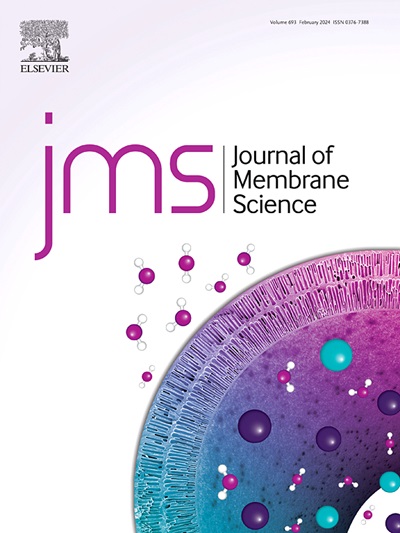用异丙醇诱导无水界面聚合,构建用于有机溶剂纳滤器的高渗透性聚酰胺膜
IF 8.4
1区 工程技术
Q1 ENGINEERING, CHEMICAL
引用次数: 0
摘要
具有精确分子筛分能力的高渗透性聚酰胺(PA)膜对于高能效化学分离至关重要。目前亟需设计出具有更强渗透性的溶剂稳定膜,以提高分离效率。在这项工作中,我们提出了一种新型的无水界面聚合(IP)方法,即将柔性聚乙烯亚胺(PEI)和刚性对苯二胺(PPD)独特地溶解在异丙醇(IPA)中,然后在原位与三甲基氯化物(TMC)交联,以制造高性能 PA 膜。值得注意的是,使用异丙醇作为溶剂代表了膜制造技术的一大进步。与传统的 PA 膜相比,这种方法制造出的 PA 膜具有相对疏松的选择性层,在保持有机溶剂纳滤(OSN)的强排斥性能的同时,还具有极高的溶剂渗透性。所获得的 PEI + PPD/TMC PA 膜在有机溶剂系统中的乙醇(EtOH)渗透率高达 46.44 L m-2 h-1 bar-1,对小分子有机物也有很好的抑制作用,如对 Eriochrome Black T(EBT,461.38 Da)的抑制率为 93.84%。此外,PEI + PPD/TMC PA 膜的性能在 510 分钟的连续交叉流过滤、高压(5 巴)测试和 6 个分离周期后仍保持在较高水平,这表明它们在长期使用中具有良好的稳定性。这项工作为利用无水 IP 反应和创新溶剂系统(如 IPA)开发高渗透 PA 膜奠定了坚实的基础。本文章由计算机程序翻译,如有差异,请以英文原文为准。

Anhydrous interfacial polymerization induced by isopropanol to construct high permeance polyamide membranes for organic solvent nanofiltration
Highly permeable polyamide (PA) membranes with precise molecular sieving capabilities are crucial for energy-efficient chemical separations. There is a critical need to design solvent-stabilized membranes with enhanced permeance to improve separation efficiency. In this work, we propose a novel anhydrous interfacial polymerization (IP) method, where flexible polyethyleneimine (PEI) and rigid p-phenylenediamine (PPD) are uniquely dissolved in isopropanol (IPA) and subsequently crosslinked with trimethyl chloride (TMC) in situ to fabricate high-performance PA membranes. Notably, the use of IPA as a solvent represents a significant advancement in membrane fabrication. This approach resulted in PA membranes with a relatively loose selective layer compared to traditional PA membranes, allowing for exceptionally high solvent permeance while maintaining strong rejection performance in organic solvent nanofiltration (OSN). The obtained PEI + PPD/TMC PA membranes demonstrated outstanding ethanol (EtOH) permeance of 46.44 L m−2 h−1 bar−1 in the organic solvent system, along with good rejection for small organic molecules, such as 93.84% for Eriochrome Black T (EBT, 461.38 Da). In addition, the performance of the PEI + PPD/TMC PA membranes remained at a high level even during 510 min of continuous cross-flow filtration, under high pressure (5 bar) testing, and after 6 cycles of separation, which demonstrated their good stability in long-term service. This work establishes a robust foundation for employing anhydrous IP reactions and innovative solvent systems, such as IPA, to develop high-permeance PA membranes.
求助全文
通过发布文献求助,成功后即可免费获取论文全文。
去求助
来源期刊

Journal of Membrane Science
工程技术-高分子科学
CiteScore
17.10
自引率
17.90%
发文量
1031
审稿时长
2.5 months
期刊介绍:
The Journal of Membrane Science is a publication that focuses on membrane systems and is aimed at academic and industrial chemists, chemical engineers, materials scientists, and membranologists. It publishes original research and reviews on various aspects of membrane transport, membrane formation/structure, fouling, module/process design, and processes/applications. The journal primarily focuses on the structure, function, and performance of non-biological membranes but also includes papers that relate to biological membranes. The Journal of Membrane Science publishes Full Text Papers, State-of-the-Art Reviews, Letters to the Editor, and Perspectives.
 求助内容:
求助内容: 应助结果提醒方式:
应助结果提醒方式:


